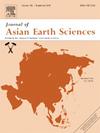Source, enrichment mechanism, and mineralization age of REY-rich phosphorites: A case study of the Early Cambrian Kunyang and Dongchuan phosphorite deposits, SW China
IF 2.7
3区 地球科学
Q2 GEOSCIENCES, MULTIDISCIPLINARY
引用次数: 0
Abstract
Sedimentary phosphorites have been recently found to have substantial concentrations of rare earth elements (REE) and yttrium (i.e., REY) which are considered strategic metals for advancing new energy and high-tech industries. This study investigates the REY enrichment mechanisms and mineralization age of REY-rich phosphorites in the Kunyang and Dongchuan phosphorite deposits using in-situ analysis of collophanite. Based on hand specimens and microscopic observations, the studied phosphorites are categorized into three types: clastic phosphorite (Type I), massive phosphorite (Type II), and striped phosphorite (Type III). The U-Pb dating of Early Cambrian phosphorites from the Kunyang deposit (Yunnan Province, SW China) yielded ages of 529.2 ± 14.8 Ma for the upper phosphorite layer and 535.1 ± 25.6 Ma for the tuff interlayer. The REY indices (e.g., LaN/YbN, Ce/Ce*, Eu/Eu*, and Y/Ho) and in-situ REY mapping indicate that diagenetic is the primary REY enrichment mechanism in both deposits. Additionally, the sub-oxidized depositional environment and reworking processes impacted REY enrichment. Hydrothermal alteration in the Kunyang phosphorites minimally affected the REY content but altered the REY pattern, whereas in the Dongchuan phosphorites, hydrothermal activity enhanced REY enrichment without altering the REY pattern. The phosphorites likely formed in a marine environment, with REY primarily sourced from seawater, while terrigenous clasts further contributed to the REY composition.

富rey磷矿成因、富集机制及成矿时代——以早寒武世昆阳和东川磷矿为例
沉积磷岩最近被发现含有大量稀土元素(REE)和钇(即REY),这些元素被认为是推进新能源和高科技工业的战略金属。利用胶磷矿原位分析研究了昆阳和东川磷矿床富REY磷矿的富集机制和成矿年龄。通过手样和显微观察,将研究的磷岩划分为碎屑磷岩(ⅰ型)、块状磷岩(ⅱ型)和条纹磷岩(ⅲ型)3种类型。云南昆阳矿床早寒武世磷岩U-Pb测年结果显示,上部磷岩层年龄为529.2±14.8 Ma,凝灰岩夹层年龄为535.1±25.6 Ma。REY指数(LaN/YbN、Ce/Ce*、Eu/Eu*、Y/Ho)和原位REY填图表明,成岩作用是两个矿床REY富集的主要机制。此外,亚氧化沉积环境和改造过程影响了REY的富集。热液蚀变对昆阳磷岩的REY含量影响不大,但改变了REY模式,而在东川磷岩中,热液活动增强了REY富集,但没有改变REY模式。磷质岩可能形成于海洋环境,REY主要来源于海水,陆源碎屑进一步促进了REY的组成。
本文章由计算机程序翻译,如有差异,请以英文原文为准。
求助全文
约1分钟内获得全文
求助全文
来源期刊

Journal of Asian Earth Sciences
地学-地球科学综合
CiteScore
5.90
自引率
10.00%
发文量
324
审稿时长
71 days
期刊介绍:
Journal of Asian Earth Sciences has an open access mirror journal Journal of Asian Earth Sciences: X, sharing the same aims and scope, editorial team, submission system and rigorous peer review.
The Journal of Asian Earth Sciences is an international interdisciplinary journal devoted to all aspects of research related to the solid Earth Sciences of Asia. The Journal publishes high quality, peer-reviewed scientific papers on the regional geology, tectonics, geochemistry and geophysics of Asia. It will be devoted primarily to research papers but short communications relating to new developments of broad interest, reviews and book reviews will also be included. Papers must have international appeal and should present work of more than local significance.
The scope includes deep processes of the Asian continent and its adjacent oceans; seismology and earthquakes; orogeny, magmatism, metamorphism and volcanism; growth, deformation and destruction of the Asian crust; crust-mantle interaction; evolution of life (early life, biostratigraphy, biogeography and mass-extinction); fluids, fluxes and reservoirs of mineral and energy resources; surface processes (weathering, erosion, transport and deposition of sediments) and resulting geomorphology; and the response of the Earth to global climate change as viewed within the Asian continent and surrounding oceans.
 求助内容:
求助内容: 应助结果提醒方式:
应助结果提醒方式:


